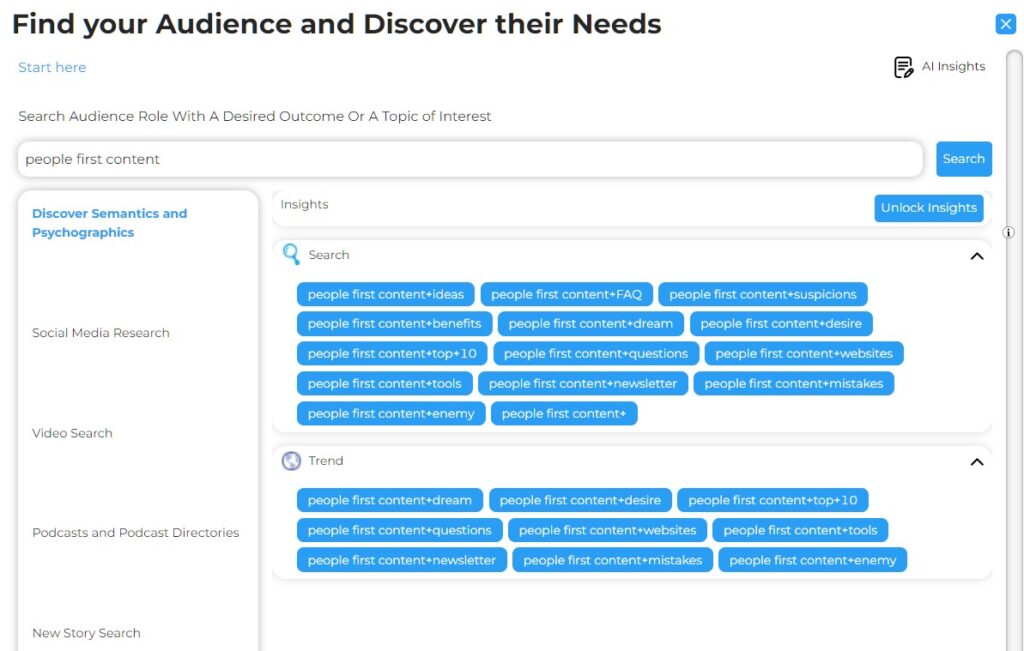
A website is a fantastic tool for connecting your business to potential clients, but only if they can find it. That’s where content marketing comes in. You identify your ideal client and create helpful content they will want to read.
In talking to small businesses I often come across variations of this: “I’ve seen online I have to get backlinks to hack the Google algorythm”. If that doesn’t make any sense to you don’t worry, it’s not the approach I’d recommend.
Instead, I’d focus on creating content that puts people first, rather than search engines.
What is People First Content?
Let’s start off with what I mean by “people first content”:
People first content means that the content is created for people, not machines. This allows you to target your audience more effectively and create content that is both engaging and informative.
The content is created with the intention of providing value to the reader or viewer, rather than solely for the purpose of ranking highly in search engine results pages (SERPs).
This type of content generally provides more informative, helpful, and engaging information than traditional SEO-focused content. It helps build trust and relationships with potential customers by delivering relevant and valuable information, instead of just trying to sell them a product or service.
When creating people first content, you should keep their audience’s needs and interests top of mind in order to produce material that will truly be useful and interesting to them.
Why Is It Important to Create Content That Isn’t SEO First ?
Rewind back 10 to 15 years and SEO content writing would mean using simple tricks, like stuffing a blog post with the word or term you want to rank for, to trick search engines.
Here’s the thing, Google got smart!
Think about how far they’ve come in that time. They created Google Maps, they’ve got a voice-controlled assistant, they’ve dominated mobiles with Android.
The old school tricks don’t work any more, and that’s a good thing. It means content creators have to put the work in to write useful, informative content that will help our visitors.
When you write content that is people first, you are more likely to attract visitors who are genuinely interested in what you have to say. This leads to higher engagement rates and conversions.
How Can AI Tools Help With Creating People First Content?
Creating original content for your ideal audience is a big ask for business owners. We’ve got other things to be doing and writing an article can take a lot of time.
Fortunately there are tools available to speed up the process, I’m using one right now!
Let’s take a look at the steps I use to create content:
Step 1: Define the audience
Before considering what to write, you need to know who you’re writing for. The content created for a single dad in the UK is going to be very different to a mother of 5 in America.
You will have an idea who your target audience is, by creating an avatar your can delve deeper into their wants and needs. This can be done manually, researching and coming up with the ideas, however I use a tool called CrawlQ to automate this process. After entering a few details it goes away and researches my ideal reader in preparation for creating content.
An ideal reader is someone who wants to become better informed and who wants to be engaged with the right content. This is a marketer’s dream, as it allows them to connect with their target audience and drive engagement. People First Content Update makes this possible by creating engaging content that resonates with your customer’s persona.
Step 2: Find something to write about
If you’re writing content for your business this should be a fairly easy step. Your business provides a product or service, presumably this helps solve a problem.
To come up with ideas on what to write you need to spy on your audience. Google is a great tool for research, but it can be tricky to think of what to search for. Try searching for things like “How to…” or “What…”, making sure to include your product and service.
Checking out the search results will show you what people are searching Google for, and that gives you ideas what content to write.

It can be easy of falling into the trap of searching for the terms over and over, so I’ll often get inspiration from the CrawlQ spying module, which suggests different search terms to investigate.

Step 3 Research and write your content
Now you know what you’d like to write about you can put fingers to keyboard. This is where your experience can shine through to the reader, and set you apart from the competition.
Make your content original with helpful information, your own analysis, and original photos.
This is where AI can help speed up the process and help you create a really great article.
I often know what I want to say but sometimes struggle to get started. I use CrawlQ to give me a basic draft on the topic and to help me add in additional information.
If you’re answering a question make sure to answer it at the start of the article, before covering the topic in general. Don’t make people hunt around for the answer they’re looking for.
Always keep the reader in mind, imagine you’re explaining the topic over a drink, what do they need to know and what questions will they ask.
Conclusion
In a world where SEO and AI are constantly changing, it’s important to remember that your content should be people first. Write for your audience and not for the search engines. Understand what they want to read and give them the information they need in a way that is easy to digest. Use tools like CrawlQ to help you update your content so that it is always fresh and relevant.
- SEO Content vs. Social Media Content: What’s the Difference? - 23/10/2025
- The Best Types of Content for Service Businesses - 16/10/2025
- How Blogging Drives Leads for Local Businesses - 10/10/2025


